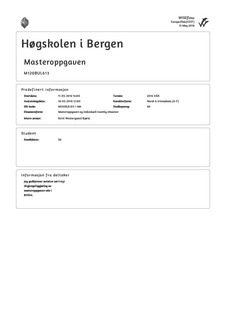| dc.contributor.author | Bråten, Guro | |
| dc.date.accessioned | 2018-02-01T14:40:56Z | |
| dc.date.available | 2018-02-01T14:40:56Z | |
| dc.date.issued | 2016-05-16 | |
| dc.identifier.uri | http://hdl.handle.net/11250/2481400 | |
| dc.description | Master i barne- og ungdomslitteratur | en_GB |
| dc.description.abstract | Oppgåva er ein tekstanalyse av korleis bildebøkene Bak Mumme bor Moni (2000), Snill (2002) og Sinna Mann (2003) av Gro Dahle og Svein Nyhus framstiller sinne og korleis bøkene legg til rette for at barn og unge kan bli kjend med seg sjølv, forstå og bearbeide eigne kjensler. Bildeboka vert i dag sett som ein estetisk heilskap der tekst og bilde interagerer med kvarandre og med lesaren for å formidle eit innhald. Bildebokmaterialet i denne oppgåva representerer moderne bildebøker som gjennom tematikk og form formidler vonde, vanskelege og sterke kjensler. Bak Mumme bor Moni tematiserer eit demonisk barnesinne personifisert i figuren Moni og barnet sin kamp mot å lære seg å kjenne og temje sinnet sitt. Snill skildrar ei ung jente sin kamp mot snillheits- og perfeksjonstyranniet der ho må lære seg å bli sint for å bli fri. Sinna Mann skildrar ein valdeleg far sitt skremmande sinne og sonen si redsle og utryggleik i ein ustabil kvardag. Bildebøkene skildrar ulike aspekt ved sinnekjensla. Oppgåva skildrar korleis barn og unge kan involvere seg med dei fiktive karakterane og «prøve på» karakterane sine tankar og kjensler ved hjelp av theory of mind og på denne måten utvikle både sjølvinnsikt, emosjonell kompetanse i tillegg til sosiale kompetanse. Generell kognitiv litteraturteori, litteraturprofessorane Maria Nikolajeva og Lisa Zunshine samt transaksjonsteoretikar Louise M. Rosenblatt dannar det teoretiske grunnlaget for oppgåva. I tillegg er teori knytt til bildebokanalyse viktige reiskapar i møte med bildebøkene. Ved å støtte meg til Nikolajeva sitt omgrep emotion ekphrasis, Zunshine si skildring av lesaren si mind-reading i møte med litterære karakterar ved hjelp av theory of mind og Rosenblatt si forståing av ulike lesemåtar har eg sett korleis bildebøkene potensielt kan engasjere ulike lesarar både kognitivt og affektivt. Bildebøkene formidlar sinnekjensla gjennom det verbale og det visuelle og ikonoteksten framstår i alle bøkene som ekspressiv, ekspanderande og med tolkingsrom for lesaren. Gjennom analysane har eg funne ut at lesaren sin ToM ligg til grunn for lesaren sine fortolkingar av visuelle og verbale ekfrasar for emosjonar og at fortolkingane er avhengig av lesarane sin førkunnskap og erfaringar. «Bildeboktrilogien» framstår som ambivalent med stort potensiale for stimulere lesarar på ulike nivå. | en_GB |
| dc.description.abstract | The thesis is an analysis of how the picturebooks Behind Mumme lives Moni (Bak Mumme bor Moni, 2000), Nice (Snill, 2002) and Angry Man (Sinna Mann, 2003) by author Gro Dahle and illustrator Svein Nyhus, portray anger through the iconotext dynamics of the books, and also how the books facilitate enhanced knowledge of one self and processing of the one's own emotions. Picturebooks today are considered an aesthetic whole where text and illustrations are closely intertwined and interact with each other and with the reader. The picturebooks mentioned above are psychologial crossover books for both children and adults. They all represent the postmodern picturebook which typically deals with difficult emotions. Behind Mumme lives Moni is about the demonic anger of a sensitive young boy personified in the character Moni. The book portrays the boy's struggle to free himself from Moni and the uncontrollable fists he causes. Nice depicts a nice, perfect girl whose niceness causes her to become invisible and her subsequent struggle out of the perfection tyranny. Little Lussi must master the act of getting angry to free herself from rigid roles limitations, and expectations. Angry Man, on the other hand, portrays a violent father and his terrified son, thus theming domestic violence and destructive family dynamics. The thesis examines how young readers can involve themselves emphatic with the fictional characters and engage in mind-reading by ascribing to a character certain thoughts and emotions based on observable behavior. This way the reader develop self-knowledge, emotional, and social competence through introspection and reflection. Cognitive criticism and literature professors Maria Nikolajeva and Lisa Zunshine, as well as transaction theorist Louise M. Rosenblatt make up the theoretical foundation of the thesis. In addition, theory regarding the picturebook genre provide relevant tools when analyzing the picturebooks of current interest. The concept of emotion ekphrasis, developed by Nikolajeva, along side Zunshine's depiction of the readers' mind-reading ability when facing a fictional character by activating their Theory of Mind provide interesting approaches to the psychological picturebooks. Moreover, Rosenblatt's transactional theory of literature emphasizes the literary experience as a give-and-take relationship between the text and the reader, where the reader continually changes between 'reading for purpose' and 'reading for aesthetic experience', is an important perspective concerning this thesis statement. | en_GB |
| dc.language.iso | nno | en_GB |
| dc.publisher | Bergen University College | en_GB |
| dc.rights | Attribution 3.0 Norway | * |
| dc.rights.uri | http://creativecommons.org/licenses/by/3.0/no/ | * |
| dc.title | Bearbeiding av kjensler gjennom bildebøker | en_GB |
| dc.title.alternative | Processing emotions through the use of picturebooks | en_GB |
| dc.type | Master thesis | en_GB |
| dc.subject.nsi | VDP::Samfunnsvitenskap: 200::Pedagogiske fag: 280 | en_GB |

